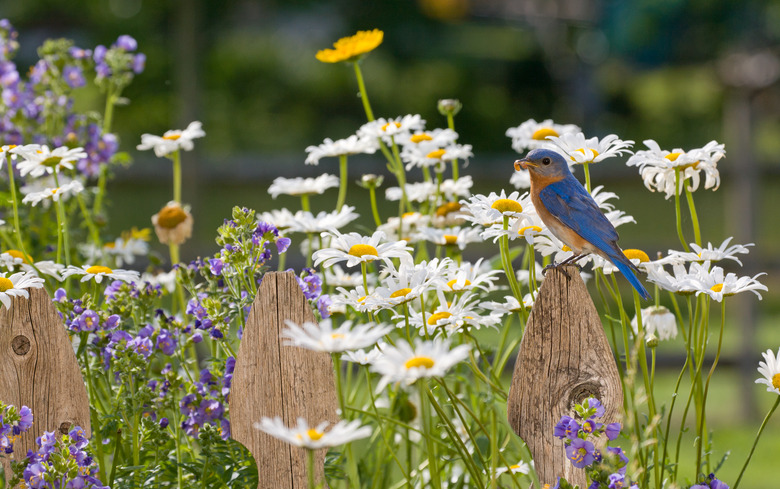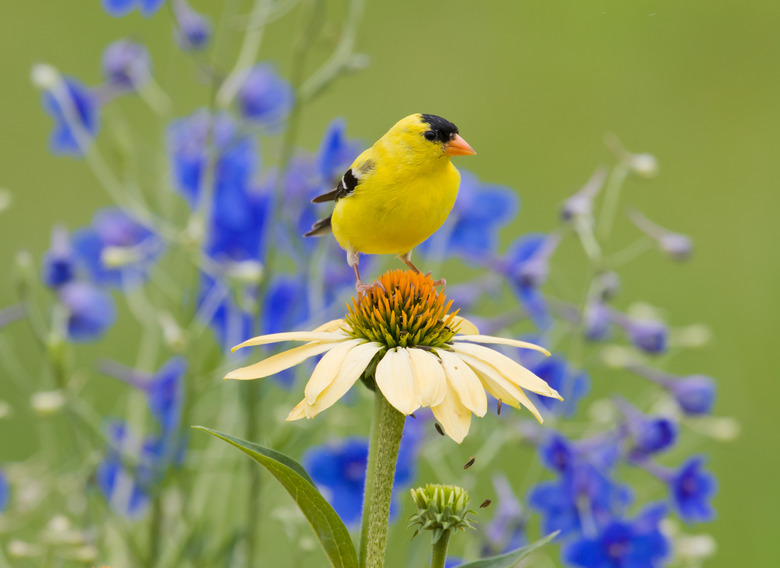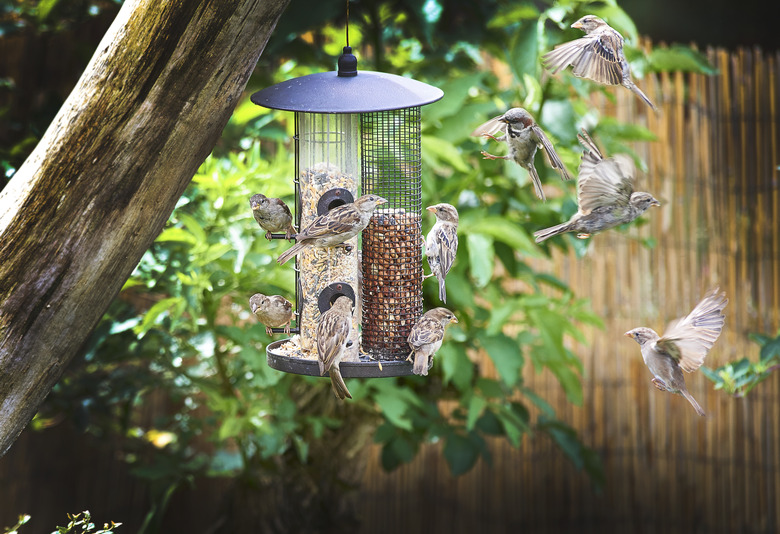Creating A Bird-Friendly Garden At Home
We may receive a commission on purchases made from links.
A bird-friendly garden contains all of the elements needed to attract the attention of local and migratory birds and to help them thrive. In many ways, this type of garden isn't very different from any other type of landscaping, though there are specific requirements for selecting and placing plants.
Bird-friendly gardens provide the necessities of life. They include food sources, water, shelter and a place to raise young. Plants can provide at least three of those elements, and you can add a water source for a complete garden. When you think of plants for your bird-friendly garden, think of the whole range of plants, from trees to shrubs to flowers to grasses to ground covers. Each type of plant provides a necessary component for your bird-friendly garden.
Bird-Friendly Garden Designs
Bird-Friendly Garden Designs
If you visit an area with a healthy bird population, such as a wooded area, you will see the basic blueprint for a bird-friendly garden. There are a variety of plant types of different heights and characteristics. It is a layered arrangement that gives birds places to build nests, food for which to forage and perches from which to sing. The wood thrush, for example, sings from perches high in the trees, but they build nests in tall shrubs below.
A bird-friendly garden on a suburban lot may have tall trees along the edges of the property with shorter trees, shrubs, grasses and herbaceous perennials and annuals planted as you move closer to the house. If you already have tall or medium-height trees on your property, you can plant shorter plants around them to create the layered arrangement favored by many birds.
Plant clumps of the same species of plants because the large amount of berries, nuts or seeds will attract birds. Dense, thick shrubs planted in clumps also provide shelter. Groups of evergreen conifers provide nesting sites and shelter during storms and winter weather. Some plants require cross-pollination between plants to produce blooms and fruit. Also, shrubs, perennials, annuals and grasses look better when planted in groups rather than as single specimens.
Attracting a large number of backyard birds could have unforeseen consequences. All those juicy berries and fruits you will be growing may attract deer and rabbits. Your visiting birds could become a target for hawks and other predators. Birds colliding with windows or attacking windows is another possibility.
Reduce Lawn Size
Reduce Lawn Size
Most bird-friendly gardens contain very little lawn area and many plantings — particularly of native species. Turfgrass does not provide much in the way of food or nest-building material for most birds, but some birds, such as robins, forage for food on the ground. If you do have a lawn, avoid the use of chemical pesticides to keep the birds safe and to allow for an insect population that will feed the birds.
Some practices contradict typical gardening practices. For example, dead trees that are hollowed out, called snags, provide nesting space for many types of birds, including woodpeckers. The same is true of brush piles. So, rather than removing all garden debris at the end of the growing season, create a brush pile of logs and smaller branches in a corner of the yard. Some birds, such as house wrens, will search through the pile for food. Others, such as northern cardinals, will roost in the piles.
Bird-Friendly Plants
Bird-Friendly Plants
One of the cornerstones of a bird-friendly garden is the use of native plants. These are plant varieties that are indigenous to your area. They have evolved to adapt to the local types of soil, the climate and the rainfall. They have also built up defenses against pests and diseases.
Not only have the plants evolved but the native bird population and the insects on which many birds feed have adapted to the plants. They are all interconnected. A native oak tree can support over 500 species of caterpillars, while a ginkgo, a common landscape tree from Asia, can support five. That's a big difference when 96 percent of terrestrial bird species feed insects, including caterpillars, to their young.
Native plants are beneficial to humans as well. Because they've adapted to local conditions, they usually require less water than a nonnative species. They can survive on the naturally occurring nutrients in the soil, so there is less need for additional fertilization. The layered planting strategy can help trap rainwater and prevent runoff.
Many of the plants you will see at the garden center or online are not native plants, but they are species that have proven popular over the years. The United States Department of Agriculture Cooperative Extension office in your area may be able to supply a list of native plants and native trees. There are also bird and plant organizations, such as The National Audubon Society, that can help you track down plants that are native to your area.
While planting native plants is important, it is just as important to not plant invasive species of plants. Invasive species can take over a garden, competing with beneficial plants for moisture and nutrients. For a list of invasive plants, contact the local cooperative extension office.
Provide Year-Round Food
Provide Year-Round Food
If you plant a bird-friendly garden, you may notice that the cast of characters changes throughout the year. There will be migratory birds that visit in the spring and fall as well as long-term residents. Different birds are attracted to different types of food. By planting a variety of plants, you can provide the fruits, nuts, berries, seeds and nectar that birds need.
When birds are raising their young, they need energy to hunt down insects for the babies. They like sweet fruits, such as blackberries and cherries. Birds will compete with you for some fruit crops. Many bird-conscious gardeners cover most of their fruit trees and shrubs with netting and leave one or two open for birds.
Flowering plants that produce seeds, such as asters and sunflowers, provide food for a variety of birds, including finches, vireos and others. Birds that migrate in the fall, such as warblers and thrushes, need fatty foods for their journey. They can find them on such plants as flowering dogwood and maple leaf viburnums.
In many parts of the country, birds overwinter, which means they do not migrate. These birds, such as waxwings and cardinals, rely on plants that provide persistent fruit — fruit or berries that do not drop but stay attached to the branch or shrub. Crabapples, bayberry, holly, Virginia creeper and other plants provide persistent fruit.
Some birds rely on the nectar of some flowering plants. Hummingbirds seem suspended in air as they drink from tubular flowers. Brightly colored flowers, such as orange honeysuckle and butterfly milkweed, attract birds. Milkweed is also a favorite of monarch butterflies.
Provide Fresh Water
Provide Fresh Water
Birds get most of the water they need from the foods they eat, but most will happily drink from and splash around in a birdbath or some other water source, such as a garden pond. This is especially true in winter when streams and lakes may be frozen. Birds also use water to cool off during hot weather.
Birdbaths you place in your yard should only be a couple of inches deep. Birds are attracted to running water, so a bath that includes a fountain where the water drips from one level to one below is a good choice. Keep the fountain clean by emptying it every few days and clean it with a stiff brush before refilling. If you live in a cold climate, add a birdbath heater to keep the water flowing throughout the winter.
Place the birdbath about 5 or 10 feet away from dense foliage. This means that predators, such as cats, have to reveal themselves in the open area. This gives birds drinking at the birdbath plenty of time to make an escape, especially if the ledge of the birdbath is a few feet off the ground.
Bird-Friendly Shelters
Bird-Friendly Shelters
Birds that nest in tree cavities may use a nesting box that you install. The nesting boxes should be simple and should be made from wood. Don't use pressure-treated wood and don't paint the inside of the box, as the paint chips could harm the young. The box should have a sloped roof to shed rain, drainage holes in the bottom and ventilation holes near the top. Some boxes have hinges that allow you to open the box for cleaning.
The opening of a nesting box should be 1 1/2 inch in diameter at the most. There should not be a perch under the opening. Starlings and house sparrows will use the perch to peck at the birds inside.
Place nesting boxes about 25 feet apart because many species are territorial and do not like other nests too close by. It's best to avoid attaching the box to a building or even a tree. Rather, mount it to a metal pole about 5 or 6 feet off the ground. The pole will let you install baffles or some other type of predator guard that will prevent cats, squirrels and raccoons from reaching the box.
Add Bird Feeders
Add Bird Feeders
The native plants you include in your garden will provide food for visiting and resident birds, but you can supplement that food by hanging bird feeders in the yard. In addition to increasing the variety of food available, the feeders can supply added food when the natural sources are scarce, such as during the winter.
Bird feeders will also help you in your attempts to observe and even photograph the birds when they come to feed. If you place the feeder near the house, you can watch the birds from inside the house or from a patio or deck.
Bird feeders come in different styles and sizes. Some are simply shallow, open trays that you hang from a tree branch. The best types keep the bird seed dry, which helps prevent it from getting moldy. Hopper-style bird feeders enclose the seed in a clear plastic chamber that has a roof. There's a ledge or perches at the bottom of the chamber where birds can rest to eat the seeds that come out of the bottom of the hopper.
Classic tube-style feeders may be the most recognizable type. Seed is placed in the plastic tube and is dispensed at the tube's bottom or at openings along the side of the feeder.
Nectar feeders are designed to attract hummingbirds. Some designs are very elaborate, including those made of blown glass. The birds don't care, but they do like the nectar that is inside, which is basically sugar and water. Hummingbird feeders are always red because the birds are attracted to bright colors.
Suet cages are open-grid metal boxes. The birds alight on the cage and feed through the grid openings. Suet is compressed animal fat that is a great source of energy for birds that normally feed on insects. Many people hang suet cages in winter, but they can be used all year.
For best results, use a variety of feeders filled with different types of bird seed to attract different species. As with a water source, keep the feeders away from the hiding places of predators.
References
- National Audubon Society: Native Plants Database
- The National Wildlife Federation: Attracting Birds
- National Audubon Society: Why Native Plants Are Better for Birds and People
- Iowa State University Extension and Outreach: Attracting Birds to Your Yard
- University of New Hampshire Extension: How Can I Get Birds to Use Birdhouses in My Yard and Garden?


